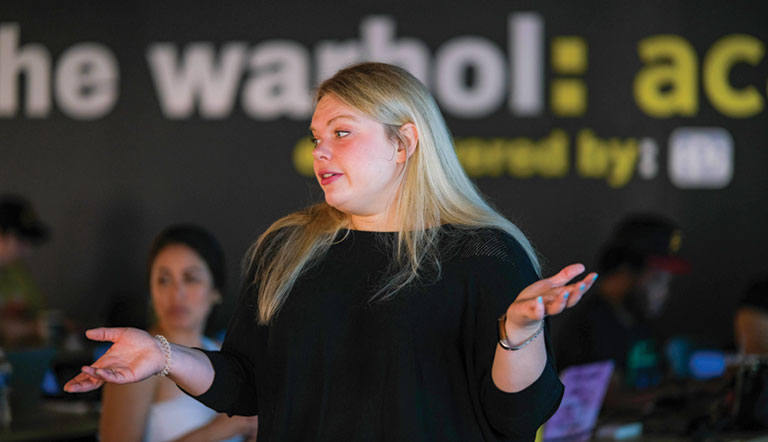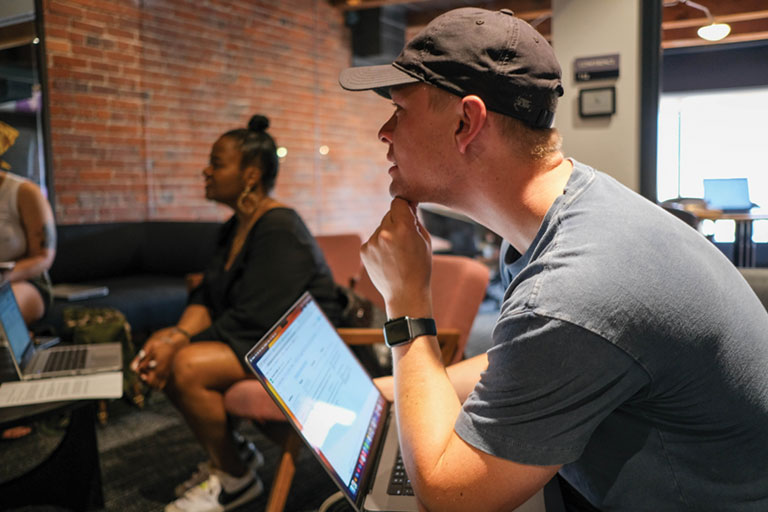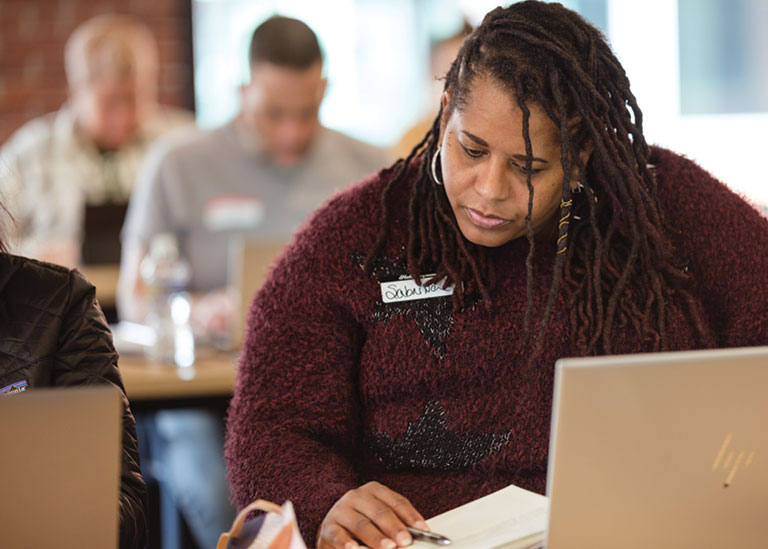The view from the seventh floor conference room at 106 Isabella St. is pure Pittsburgh. The windows from this North Shore vantage point—home to The Andy Warhol Museum’s Pop District initiative—perfectly frame the Andy Warhol Bridge as it spans the Allegheny River and pumps traffic into the heart of downtown.
It’s a scene that evokes the city’s industrial past, offers a snapshot of the present, and, for the people gathered at The Pop District headquarters one recent Saturday afternoon, includes a future full of possibilities.
In May 2023, the state of Pennsylvania licensed Carnegie Museums of Pittsburgh to launch its first-ever diploma program—a digital marketing program based in The Pop District. The Warhol welcomed the inaugural diploma class in June, which means that students who are scheduled to complete the 24-week program this December will earn a diploma signed, sealed, and ready for touting on resumes and hanging on office walls.
According to Ryan Haggerty, who oversees the new diploma program, Pittsburgh’s shift to a more creative economy is the driving force behind the initiative.
“We’re offering accessible programming that speaks to what is in demand, what employers are looking for,” Haggerty says. “But we’re also working with each individual to help them achieve their personal goals.
“We’re going to see what comes out of this, where our students take it next, and how that will impact Pittsburgh.”

“We’re offering accessible programming that speaks to what is in demand, what employers are looking for. But we’re also working with each individual to help them achieve their personal goals.”
–Ryan Haggerty
The brainchild of The Warhol, The Pop District—a multidimensional project designed to transform Pittsburgh’s eastern North Shore neighborhood into a cultural, educational, and economic juggernaut, with The Warhol as its anchor—officially launched in 2022.
One of its flagship initiatives was a youth-focused workforce development component that teaches skills needed to participate in the creative digital economy. The digital marketing diploma program is an important part of that.
“Being able to say that we are state-licensed to provide a diploma program carries weight,” Haggerty says. “Employers see value in it because it tells them that our participants went through a program, and they were dedicated to it and completed it.”
According to Maddi Love, one of the program’s primary instructors, gaining state approval is no small feat. “It’s a long, arduous process,” she says. “There’s a lot of scrutiny from the Department of Education. They ask a lot of specific questions about how this course will be helpful for people, and you have to have direct answers.”

With 15 years of professional digital marketing experience, Love developed a strong, forward-looking curriculum.
“I care about giving people the skills to work in the digital realm effectively,” she says. “I’m no guru, but I’ve seen the ways people do it wrong and get complacent. All of the programs and platforms we’re talking about today are going to change in six months. For us, it’s about teaching people to teach themselves so that they are able to understand the fundamental aspects of the technology.”
“I look at the folks in this program as people who understand new ideas and new ways of building marketing departments or getting a product out. So, yes, I would definitely be inclined to take a deeper look at someone who has graduated from the diploma program.”
–Christian Lockerman, executive producer of The Warhol Creative
As someone who is in the unique position of being a Pop District insider as well as a potential employer, Christian Lockerman appreciates the long-term, big-picture perspective.
“I look at the folks in this program as people who understand new ideas and new ways of building marketing departments or getting a product out,” says Lockerman, the executive producer of The Warhol Creative, The Pop District’s in-house digital media production studio that offers on-the-job training to young, and not-so-young, creators. “So, yes, I would definitely be inclined to take a deeper look at someone who has graduated from the diploma program.”
Before there was Internet
At first glance, the 12 people huddled around their laptops at a conference table seem to have little in common. There’s a range of ages (from 20s to 50-plus), races, ethnicities, and tattoos.
But once the conversation turns from casual chatter to intense talk of Scrum (a project management system), HubSpot (a CRM, or customer relationship management platform), and SEO (search engine optimization), they settle in on a shared goal: learning the fundamentals of online marketing.
Meeting virtually for two hours on Tuesday and Thursday evenings and for four hours in person on Saturdays, the digital marketing class offers hands-on training in 21st century skills. And it’s free, at least for now.
“Normally, the program would be $8,000 [per student],” Haggerty says. “But because we’re fully subsidized by a mix of philanthropic funding and corporate sponsorships, people are able to come in and take this at no cost.”

The application process involves more than just a willingness to learn, although that is an important factor. Up to 20 openings are available for each cohort (the next one starts in February 2024), and application standards such as a logic test, writing sample, and video intro are part of the package.
“We want people to be able to demonstrate some basic digital literacy skills so that they can truly participate and benefit from the program,” Haggerty says. “But, really, what we’re looking for above all else is for people to express that this is going to be valuable to them, and how it’s going to help them achieve their goals.”
Taking his seat at the table, Christian Groblewski says his goals are pretty clear: He wants to reopen his music shop SuperMonkey. As a single 50-year-old parent and mid-career professional, the early days of COVID forced him to make some tough decisions, like shuttering his physical store and taking a more traditional job in school admissions.
Deeply steeped in the music industry (he’s a performer, promoter, and seller of merchandise), he’s continued to operate his company entirely online. Now, he’s ready to reopen SuperMonkey at a yet-to-be-determined location.
“I felt the big thing I lacked as a business owner was a good understanding of digital marketing,” Groblewski says. “Back when I went to school, we didn’t even have internet.
“Sometimes in this class I feel like the Karate Kid at the beginning of the movie, when he’s just painting the fence and wondering what’s happening. I’m waiting for that aha moment, too,” he continues. “But other times, I take what I’ve learned and I’m able to apply it immediately.”

Pointing to his computer screen, he asks, “See this https: address? Mine didn’t have an ‘s’. Do you know what that means? I didn’t.” [The “s” means all communications are encrypted, adding a level of security.] “I built this website 10 years ago, and all that time my site hasn’t been secure, and my Google ranking has suffered as a result.”
It turned out to be a quick fix, one of many changes he’s hoping to implement as he prepares to go on the offensive. “By the end of this program,” Groblewski says, “I want to be ready to attack the digital market.”
The proprietor of SuperMonkey is certainly not alone in his quest to conquer the digital universe.
According to Haggerty, Carnegie Museums’ digital marketing diploma program at The Warhol, as well as the unlicensed classes offered by a sister program, called The Warhol Academy (also overseen by The Pop District), tend to attract local business owners like Groblewski, staff from small charitable organizations, aspiring entrepreneurs, people looking to get the most out of a side gig, and career changers looking to take on new roles in digital marketing.

Haggerty says the bottom line is this: “It doesn’t matter if you’re a for-profit, a nonprofit, the UPMCs of the world, or a startup; everybody needs to have an online presence. If you’re not online, you don’t exist.”
That’s a reality COVID made stark. And that’s why Love set out to focus on all the essential, albeit frustrating, parts of digital marketing; and there are a lot.
Learning the Nitty-Gritty
“It happens all the time,” Love says. “A marketing department can’t change or edit the back end of a website because they don’t know how or they’ve been locked out. Now they have to call IT and jump through a million hoops. That’s why we teach web [development] skills.”
Other core competencies on the list include how to write Google ads, run a Mailchimp campaign, and analyze the analytics.
“There are a lot of people out there who talk about how to make great content,” Love continues. “We show you how to take C+ content—not A+—and share it with actual engagement from real people who have an interest in what you’re doing.”


“You become part of a peer group. You have people you can talk to and collaborate with, and you have people who will hold you accountable.”
–Ryan Haggerty
Still, the measure of success is as unique as a domain name.
Fionah Lynch, a recent University of Pittsburgh graduate, is taking the long view. Armed with a degree in digital media and professional communications, she landed a position at a local commercial real estate firm.
Like most first jobs, it’s not exactly the dream. “I do administrative work and some marketing,” she says, “but it’s a small company and they’re not looking to expand.”
Lynch, however, is looking to expand and grow her career, and sees this class as a means to that end. “This is a very big time commitment, more than I expected,” she says. “But I’m hoping to get hands-on experience with all these industry-standard programs. In college, we didn’t spend a lot of time doing the nitty-gritty stuff. It was much more conceptual.”
For now, her future promises resume updates reflecting her newfound digital marketing skills and state-licensed diploma.
But there are some benefits to taking this class that don’t fit neatly on a resume. Ironically, we’re talking about human interaction.

“Our instructors are working professionals, and they bring their experiences and up-to-date knowledge directly into the classroom where our students can ask questions and apply that information directly to their own projects,” Haggerty says.
“As much as we like being online,” he adds, “people do want to talk to other people.”
And keep talking, even after the course ends. Gaining contacts, making connections—it’s an old-school concept that still has a place even in this digital frontier.
“There’s a giant network here,” Haggerty says. “In addition to The Warhol, there are the other Carnegie Museums, there are our teachers and our staff, and we’re all here to help amplify whatever you’re working on.”
Lockerman puts it this way: “There’s some pull, some cachet associated with the name ‘Warhol,’ and that can help open doors.”
Haggerty also views each cohort as its own ecosystem of burgeoning influence and support. “You become part of a peer group,” he says. “You have people you can talk to and collaborate with, and you have people who will hold you accountable.”
Wanted: Lifetime Learners
Meanwhile, just across the hall, The Warhol Academy’s digital marketing training class—which is not part of the diploma program—is nearing the end of its six-month semester. This class has a greater focus on people currently employed or running a business, rather than job seekers or freelance workers, but for the same no-fee tuition.
“This class served as a model for our diploma option, which we launched just a few months later,” Haggerty says. “It not only gave us an opportunity to gauge everyone’s commitment and ability to come to the North Shore on Saturdays, it also showed that people are hungry to learn these skills, forge new relationships, and take their jobs to the next level.”

That’s what Sabrina Clark and Shyvonne Hall had in mind when they signed up. Clark, 52, works at a local nonprofit agency and built her own fashion consulting website, and Hall, 43, cultivated her own business as a YouTube design influencer with more than 105,000 subscribers.
The two arrived as strangers and now are collaborators and cheerleaders for each other’s success. They’re teaming up to tackle today’s assignment: Create 30 Google ads and 300 keywords, link the ads to a specific site or channel, and then explore the back end to determine the number of clicks, views, or purchases.
The results of this in-class task have real-world implications.

A self-described lifetime learner, Hall decided to enroll “to learn all the things about digital marketing I never even thought about before.”
Clark was just as curious, but perhaps a little bit more cautious. “I’m a woman of a particular age,” she says, “and it seemed like other classes and opportunities were just for younger people. But this class has no age limit.”
The results, Clark adds, seem limitless as well.
And that’s what The Pop District is counting on as its team hopes to make Pittsburgh a creative economy hub.
According to Lockerman, “We’ve adopted this uncopyrighted mantra that says we really want the next Andy Warhol to become the next Andy Warhol without having to leave the city.”
Haggerty offers his own variation of the mantra.
“I would hope that Andy would see this as an opportunity for more artists, more creatives, more changemakers, and more people just doing their own thing being able to make it happen here in Pittsburgh.”
THE POP DISTRICT is generously supported by: The Richard King Mellon Foundation, The Henry L. Hillman Foundation, PPG Foundation, and Dell Technologies.
Receive more stories in your email
Sign up
